North Carolina, with its diverse habitats ranging from mountains to coastal plains, provides a varied environment for wildlife, including the fascinating corn snake. This guide delves into the presence of corn snakes in North Carolina, their habitat preferences, and crucial information for responsible coexistence.
Are Corn Snakes Native to North Carolina?
Yes, corn snakes ( Pantherophis guttatus) are native to North Carolina. They are a common sight across much of the state, thriving in various ecosystems thanks to their adaptability. Their distribution stretches across the eastern portion of the US, and North Carolina falls comfortably within their natural range.
What Kind of Habitats Do Corn Snakes Prefer in North Carolina?
Corn snakes in North Carolina exhibit a preference for habitats offering shelter and access to prey. These include:
- Fields and meadows: These open areas provide ample hunting grounds for rodents, their primary food source. The presence of tall grasses and brush offers excellent cover.
- Wooded areas: The edges of forests and woodlands often provide ideal hunting and shelter locations. Fallen logs, rock piles, and burrows offer safe havens.
- Agricultural lands: Areas with crops and barns can attract rodents, which in turn attracts corn snakes seeking food. These areas also offer readily available shelter.
- Suburban areas: While less ideal, corn snakes can sometimes be found in suburban settings, especially near wooded areas or with abundant rodent populations.
What Do Corn Snakes Eat in North Carolina?
The diet of a corn snake in North Carolina primarily consists of rodents, such as:
- Mice: These are a staple food source, providing ample nutrition for these snakes.
- Rats: Larger corn snakes may occasionally prey on rats, especially in areas with high rodent populations.
- Voles: These small rodents are also a significant part of their diet.
Corn snakes are ambush predators, patiently waiting for their prey to come within striking distance. They use constriction to subdue their victims before consuming them.
Are Corn Snakes Dangerous to Humans?
No, corn snakes are not venomous and pose no significant threat to humans. They are known for their docile nature and are popular pets due to their relatively calm temperament. While they might bite if provoked or handled roughly, their bite is no more painful than a minor pinch.
How Can I Identify a Corn Snake in North Carolina?
Corn snakes are relatively easy to identify thanks to their distinctive markings:
- Color: They typically display a reddish-brown or tan body with darker saddle-shaped markings. Color variations exist, and some individuals are more brightly colored than others.
- Size: Adult corn snakes can reach lengths of 3 to 5 feet.
- Pattern: The saddle markings are characteristic and help distinguish them from other snake species.
If you are unsure about the identification of a snake, it's always best to avoid handling it and consult with a local wildlife expert or herpetologist.
What Should I Do if I See a Corn Snake in My Yard?
If you encounter a corn snake in your yard, there is generally no need for alarm. They are beneficial to have around as they help control rodent populations. The best course of action is to simply observe the snake from a safe distance and allow it to continue on its way. Providing ample cover in your yard, such as brush piles or rock piles, can encourage them to stay and help control pest populations naturally. Avoid attempting to handle the snake, as this can stress the animal and lead to a defensive bite.
Are Corn Snakes Protected in North Carolina?
Corn snakes are not currently listed as a protected species in North Carolina. However, it's crucial to practice responsible wildlife stewardship and avoid harming or unnecessarily disturbing these beneficial animals.
Where Can I Learn More About Corn Snakes in North Carolina?
For more detailed information about corn snakes and other wildlife in North Carolina, you can contact the North Carolina Wildlife Resources Commission or your local wildlife rehabilitation centers. Many universities and colleges with biology departments also offer valuable information and resources.
This comprehensive guide provides a solid foundation for understanding the presence and role of corn snakes in North Carolina's ecosystems. Remember responsible coexistence is key to ensuring the well-being of both wildlife and humans.
